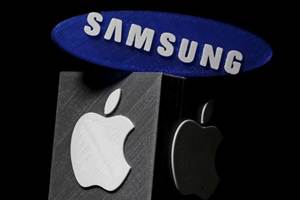U.S. Supreme Court justices questioned whether Apple Inc. should be allowed to keep all of a $399 million patent award it won in a suit that accused rival Samsung Electronics Co. of copying the design of the iPhone.
Listening to arguments Tuesday in Washington, the justices suggested they may return the case to a lower court for more hearings. But several of them said they weren’t sure how a jury or judge should decide how much Apple should collect.
A federal appeals court said Apple could collect Samsung’s entire profit from 11 phones found to have infringed Apple’s patents. The issue before the justices Tuesday was whether the owners of design patents are entitled to the entire profit from a product.
Instead, Apple, Samsung and the U.S. government agreed the patent award should be based on an “article of manufacture,” which could mean just a component of a product. The hard part, the justices said, was how to determine what that means and how to explain it to a jury.
“I simply wouldn’t know what to do,” when it came to instructing jurors, Justice Anthony Kennedy said.
Ornamental Look
Design patents cover the ornamental look of an object rather than any functional aspect. The court hasn’t considered design patents since disputes involving spoon handles in the 1870s and carpets in the 1890s.
Those cases, or ones involving the design for a wallpaper, for instance, are easier to analyze, Justice Stephen Breyer said. The question is how to handle a product that has multiple components like the modern smartphone.
Apple introduced the iPhone 2007, revolutionizing an industry that before than had received limited interest from consumers. Apple lawyer Seth Waxman said that Samsung, undergoing a “crisis of design,” simply copied the look of the iPhone to avoid a loss of market share.
Samsung lawyer Kathleen Sullivan said the entire profit wasn’t attributable just to the looks of the phone, since consumers expect more from their smartphones. It “cannot by definition cover the innards of a phone,” she said.
This was the first of two cases that Apple won at trial. Samsung sent Apple $548 million in December 2015, though it hopes to get as much as $399 million of that back if it wins the Supreme Court case, and the rest if it’s successful in invalidating other Apple patents through a process at the U.S. Patent and Trademark Office.
In a second case, Apple won $119.6 million over three patents, including the slide-to-unlock feature and technology to detect phone numbers in messages. The appeals court on Fridayreinstated that verdict, which had been thrown out by a three-judge appeals court panel in February.

